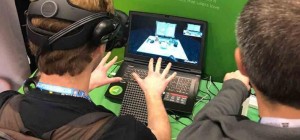Ultrahaptics, the Bristol-based mid-air touch technology innovator, has rebranded as Ultraleap four months after combining with US firm Leap Motion.
The two companies came together in May after working together for six years on their pioneering complementary technology. 
While Ultrahaptics described the move as a ‘combination’, trade media reported that it had paid around $30m (£24.1m) to acquire San Francisco-based Leap.
The rebrand aims to underline the message that, through the deal, the firms have created the world’s leading spatial interaction company.
University of Bristol spin-out Ultrahaptics had already grown into the world’s leading mid-air haptics company before the combination, having developed a unique technology that enables users to receive tactile feedback without needing to wear or touch anything.
The technology uses ultrasound to project sensations through the air and directly onto the user’s hands, enabling them to ‘feel’ virtual buttons or interact with virtual objects, pictured.
Leap Motion was founded in 2010 and has partnered with major headset manufacturers to embed its technology into VR/AR (virtual reality/augmented reality) products across the world. Last year it launched Project North Star, a fully open source hardware/software platform for prototyping AR experiences. 
Ultraleap said, since coming together in May, the two firms were “accelerating innovation in user interfaces and enhancing commercial software and hardware applications”.
The new Ultraleap brand represented a significant step forward for the combined group, while reflecting the company’s dual roots, it added.
The technology encompasses both hand tracking and mid-air haptics. The tracking technology can be embedded into any product, including VR and AR headsets. Mid-air haptics is a ‘virtual touch’ technology that uses ultrasound to project tactile sensations onto users’ hands.
Tactile, virtual interfaces are set to transform user interaction across sectors such as automotive, advertising, immersive entertainment, VR/AR, training/simulation and enterprise applications. A wide range of clients from global technology giants to creative studios have already licensed Ultraleap technology, including The Void’s Star Wars: Secrets of the Empire at Disney. In the automotive sector, the technology has been showcased in concept cars developed by Harman, and Bosch.
The Ultrahaptics and Leap Motion names will be maintained as trademarks for existing products only, with Ultraleap used for all new software and hardware launches.
Ultrahaptics CEO Steve Cliffe, now CEO at Ultraleap, said: “The story is now bigger than either Ultrahaptics or Leap Motion, and it’s about more than just haptics and hand tracking.
“We provide the world’s first full vertical stack of software and hardware for spatial (3D) interaction. We are at the epicentre of the interface revolution.
“Rebranding isn’t a decision we’ve taken lightly. We’re immensely proud of what our companies have achieved. We’re also very excited for what’s to come. Our new name and brand reflects our ambitions in this new world, now and for the future.”
The two businesses have a wide range of research-based intellectual property (IP). Their combined resources are now focused on facilitating highly engaging, natural interaction between people and machines.
Ultraleap employs nearly 150 people across UK, US and Asia.






























